12.2 Understanding Interactions in ANOVA
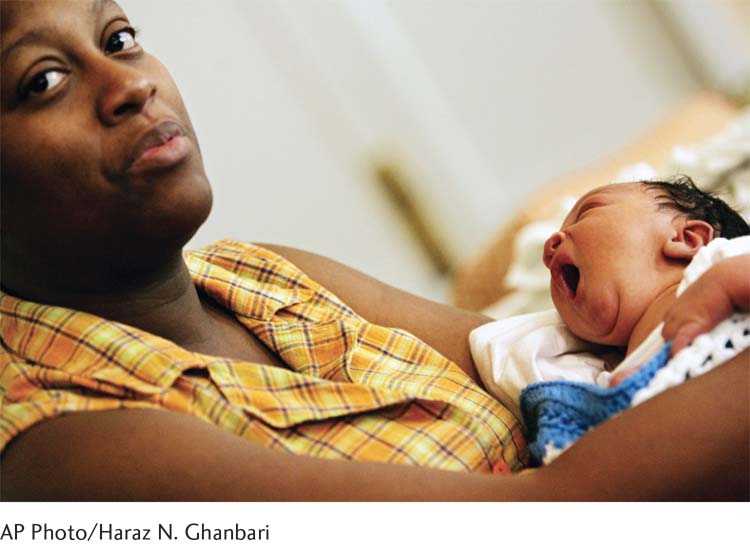
A two-
In this section, we explore the concept of an interaction in a two-
Interactions and Public Policy
Hurricane Katrina demonstrates the importance of understanding interactions. First, the 2005 hurricane itself was an interaction among several weather variables. The devastating effects of the hurricane depended on particular levels of other variables, such as where it made landfall and the speed of its movement across the Gulf of Mexico.
332
Interactions were relevant for the people affected by Hurricane Katrina as well. For example, one would think that Hurricane Katrina would have been universally bad for the health of all those displaced people—
Some women gave birth in the squalor of the public shelter in New Orleans’ Superdome or in alleys while waiting for rescuers. When it comes to pregnant women, the first priority of disaster relief agencies is to provide obstetric and neonatal care. Massive relief efforts sometimes mean that access to care for pregnant women is actually improved in the aftermath of a disaster. Of course, the quality of health care certainly doesn’t improve for everybody, which means that an interaction is involved. So the quality of health care improved for pregnant women in the aftermath of the disaster, whereas it became worse for almost everyone else. In the language of two-
Interpreting Interactions
The two-
MASTERING THE CONCEPT
12-
A quantitative interaction is an interaction in which the effect of one independent variable is strengthened or weakened at one or more levels of the other independent variable, but the direction of the initial effect does not change.
A qualitative interaction is a particular type of quantitative interaction of two (or more) independent variables in which one independent variable reverses its effect depending on the level of the other independent variable.
Quantitative Interactions Two terms often used to describe interactions are quantitative and qualitative (e.g., Newton & Rudestam, 1999). A quantitative interaction is an interaction in which the effect of one independent variable is strengthened or weakened at one or more levels of the other independent variable, but the direction of the initial effect does not change. The researcher ski bums, Jonathan Zinman and Eric Zitzewitz, found a quantitative interaction when they discovered that resort snowfall reports were always exaggerated compared to weather reports, and especially on the weekends. More specifically, the effect of one independent variable is modified in the presence of another independent variable.
A qualitative interaction is a particular type of quantitative interaction of two (or more) independent variables in which one independent variable reverses its effect depending on the level of the other independent variable. In a qualitative interaction, the effect of one variable doesn’t just become stronger or weaker; it actually reverses direction in the presence of another variable. Let’s first examine the quantitative interaction.
EXAMPLE 12.2
The grapefruit juice example is a helpful illustration of a quantitative interaction. Lipitor and Zocor lead to elevations of some liver enzymes in combination with water, but the absorption levels are even higher with grapefruit juice. This effect is not seen with a placebo, which has an equal effect regardless of beverage. Let’s invent some numbers to demonstrate this. The numbers in the cells in Table 12-4 don’t represent actual absorption levels; rather, they are numbers that are easy for us to work with as we learn about statistical interactions. For this exercise, we will consider every difference between numbers to be statistically significant. (Of course, if we really conducted this study, we would conduct the two-
333

First, we consider main effects; then we consider the overall pattern that constitutes the interaction. If there is a significant interaction, we ignore any significant main effects. The significant interaction supersedes any significant main effects.
A marginal mean is the mean of a row or a column in a table that shows the cells of a study with a two-
way ANOVA design.
Table 12-4 includes mean absorption levels for the six cells of the study. It also includes numbers in the margins of the table, to the right of and below the cells; these numbers are also means, but are for every participant in a given row or in a given column. Each of these is called a marginal mean, the mean of a row or a column in a table that shows the cells of a study with a two-
The easiest way to understand the main effects is to make a smaller table for each, with only the appropriate marginal means. Separate tables let us focus on one main effect at a time without being distracted by the means in the cells. For the main effect of beverage, we construct a table with two cells, as shown in Table 12-5. The table makes it easy to see that the absorption level was higher, on average, for grapefruit juice than for water.
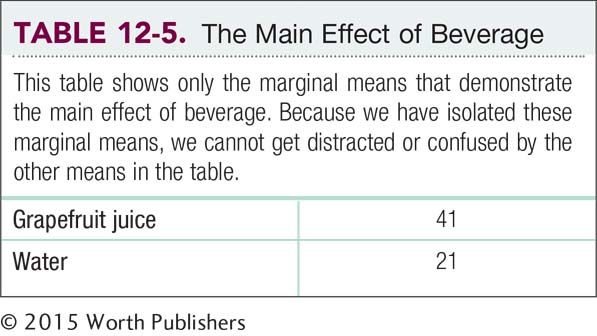
Let’s now consider the second main effect, that for medication. As before, we construct a table (such as Table 12-6) that shows only the means for medication, as if beverage were not included in the study. We kept the means for beverage in rows and the means for medication in columns, just as they were in the original table. You may, however, arrange them either way, using whichever order makes sense to you. Table 12-6 shows that the absorption levels for Lipitor and Zocor were higher, on average, than for placebo, which led to almost no absorption. Both results would need to be verified with a hypothesis test, but we seem to have two main effects: (1) a main effect of beverage (grapefruit juice leads to higher absorption, on average, than water does), and (2) a main effect of medication (Lipitor and Zocor lead to higher absorption, on average, than placebo does).
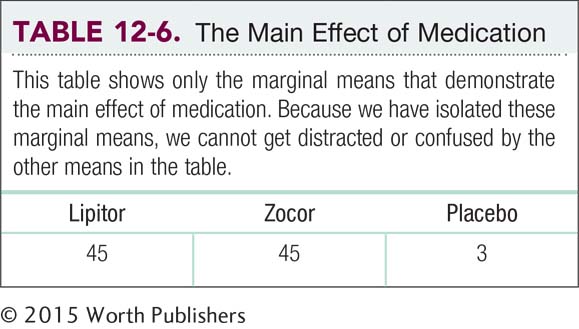
But that’s not the whole story. Grapefruit juice, for example, does not lead to higher absorption, on average, among placebo users. Here’s where the interaction comes in. Now we ignore the marginal means and get back to the means in the cells themselves, seen again in Table 12-7. Here we can see the overall pattern by framing it in two different ways. We can start by considering beverage. Does grapefruit juice boost mean absorption levels as compared to water? It depends. It depends on the level of the other independent variable, medication; specifically, it depends on whether the patient is taking one of the two medications or a placebo. We can also frame the question by starting with medication. Do Lipitor and Zocor boost mean absorption levels as compared to a placebo? It depends. They do anyway, even just in conjunction with water, but they do so to a far greater degree in conjunction with grapefruit juice. This is a quantitative interaction because the strength of the effect varies under certain conditions, but the direction does not.
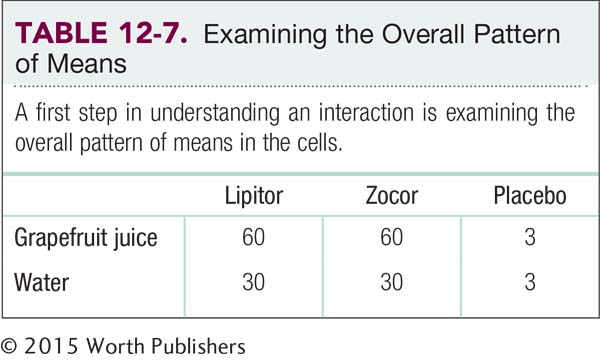
334
People sometimes perceive an interaction where there is none. If Lipitor, Zocor, and a placebo all had higher mean absorption rates in conjunction with grapefruit juice (versus water), there would be no interaction. Lipitor and Zocor would always lead to a particular increase in average absorption levels versus a placebo—

Bar Graphs and Interactions
Bar graphs help us determine if there really is an interaction. The bars in this graph help us to see that, among those taking the placebo, absorption is the same whether the placebo is accompanied by grapefruit juice or water, whereas among those taking Lipitor or Zocor, absorption is higher when the medications are accompanied by grapefruit juice than when they are accompanied by water.
The bar graph helps us to see the overall pattern, but one more step is necessary: to connect each set of bars with a line. We have two choices that match the two ways we framed the interaction in words above: (1) As in Figure 12-3, we could connect the bars for the first independent variable, medication. We would connect the three medications for the grapefruit condition, and then we would connect the three medications for the water condition. (2) Alternatively, as in Figure 12-4, we could connect the bars for the two beverages. We would connect the two beverages for Lipitor, for Zocor, and for placebo.

Are the Lines Parallel? Part I
We add lines to bar graphs to help us determine whether there really is an interaction. We draw a line connecting the three medications under the grapefruit juice condition. We then draw a line connecting the three medications under the water condition. These two lines intersect, an indication of an interaction that can be confirmed by conducting a hypothesis test.
335

Are the Lines Parallel? Part II
There are always two ways to examine the pattern of the bar graphs. Here, we have drawn three lines, one connecting the two beverages under each of the three medication conditions. Were the three lines to continue, the two medication lines would eventually intersect with the horizontal placebo line, an indication of an interaction that can be confirmed by conducting a hypothesis test.
In Figure 12-4, notice that the lines do not intersect, but they’re not all parallel to one another either. If the lines were extended far enough, eventually those connecting the two bars for each medication would intersect the line connecting the bar for placebo. Perfectly parallel lines indicate the likely absence of an interaction, but we almost never see perfectly parallel lines emerging from real-
Some social scientists refer to an interaction as a significant difference in differences. In the context of the grapefruit juice study, the mean difference between grapefruit juice and water is larger when participants are taking one of the medications than when they are taking the placebo. In fact, for those taking the placebo, there is no mean difference between grapefruit juice and water. This is an example of a significant difference between differences. This interaction is represented graphically whenever the lines connecting the bars are significantly different from parallel.
However, if grapefruit juice also led to an increase in mean absorption levels among those taking the placebo, the graph would look like the one in Figure 12-5. In this case, the mean absorption levels of Lipitor and Zocor do increase with grapefruit juice, but so does the mean absorption level of the placebo, and there is likely no interaction. Grapefruit juice has the same effect, regardless of the level of the other independent variable of medication. When in doubt about whether there is an interaction or just two main effects that add up to a greater effect, draw a graph and connect the bars with lines.
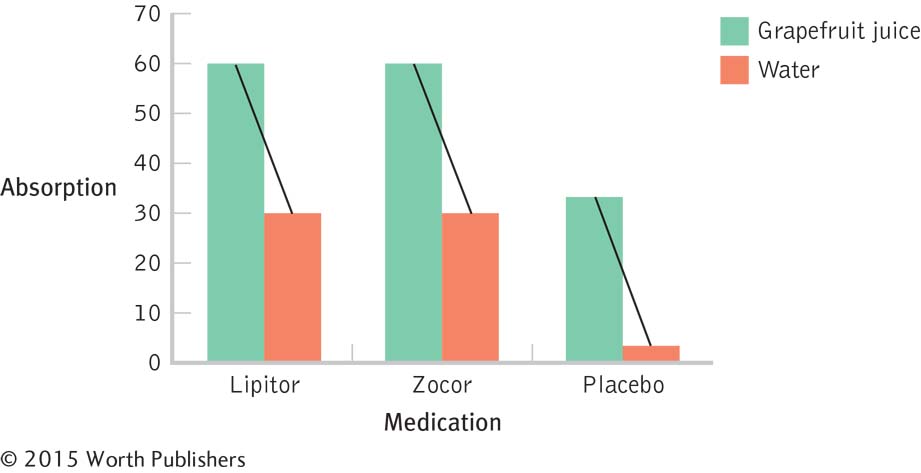
Parallel Lines
The three lines are exactly parallel. Were they to continue indefinitely, they would never intersect. Were this true among the population (not just this sample), there would be no interaction.
336
However, don’t just draw lines and skip the step of creating the bar graph. Ali and Peebles (2012) found that line graphs were more frequently misinterpreted than bar graphs. In one of their experiments, students randomly assigned to interpret line graphs were significantly more likely than students randomly assigned to interpret bar graphs to ignore the variable on the x-axis. Those interpreting line graphs were more often also unable to explain the finding at all than were those interpreting bar graphs. In addition, Zacks and Tversky (1997) reported that some people view lines as indicating a continuous variable in a line graph. A participant in one of their experiments viewed a line graph and stated: “The more male a person is, the taller he/she is” (p. 148). A bar graph would likely have led that participant to perceive, accurately, that men are, on average, taller than women.
Qualitative Interactions Let’s recall the definition of a qualitative interaction: a particular type of quantitative interaction in which the effect of one independent variable reverses its effect depending on the level of the other independent variable.
EXAMPLE 12.3
Do you think that, on average, people make better decisions when they consciously focus on the decision? Or do they make better decisions when the decision-
In one study, participants were asked to choose one of four cars. One car was objectively the best of the four, and one was objectively the worst. Some participants made a less complex decision; they were told 4 characteristics of each car. Some participants made a more complex decision; they were told 14 characteristics of each car. After learning about the cars, half the participants in each group were randomly assigned to think consciously about the cars for 4 minutes before making a decision. Half were randomly assigned to distract themselves for 4 minutes by solving anagrams before making a decision. The research design, with two independent variables, is shown in Table 12-8. The first independent variable is complexity, with two levels: less complex (4 attributes) and more complex (14 attributes). The second independent variable is type of decision making, with two levels: conscious thought and unconscious thought (distraction).
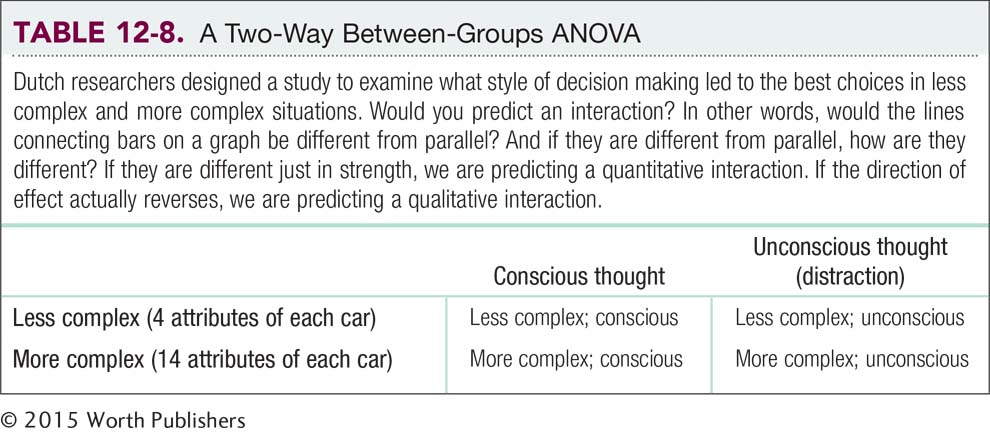

The researchers calculated a score for each participant that reflected his or her ability to differentiate between the objectively best and objectively worst cars in the group. This score represents the dependent variable, and higher numbers indicate a better ability to differentiate between the best and worst cars. Table 12-9 presents the cell means and marginal means for this experiment. For the teaching purposes of this example, note that (a) the cell means are approximate, (b) the marginal means assume the same number of participants in each cell, and (c) all the observed differences are statistically significant. (In a real research situation, we would conduct an ANOVA to determine statistical significance.)
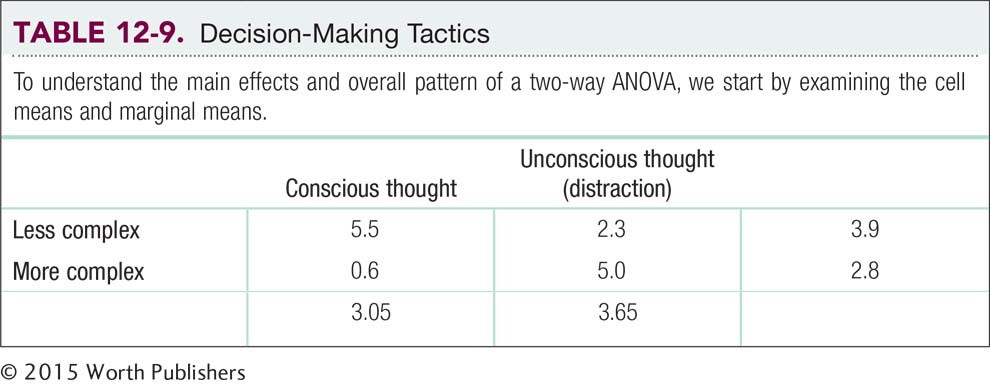
337
Because there was an overall pattern—
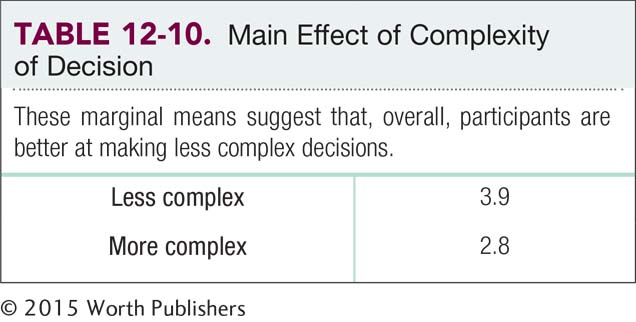

However, if there is also a significant interaction, then these main effects don’t tell the whole story. The interaction demonstrates that the effect of the decision-
338
A bar graph, shown in Figure 12-6, makes the pattern of the data far clearer. We can actually see the qualitative interaction.
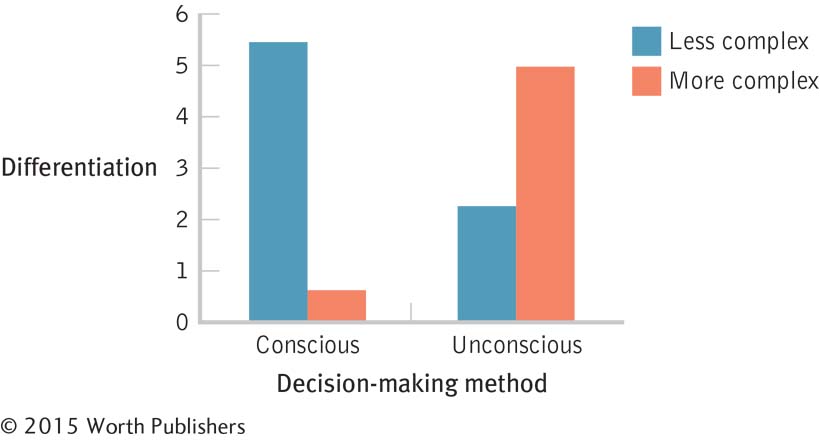
Graphing Decision-
This bar graph displays the interaction far better than a table or words. We can see that it is a qualitative interaction; there is an actual reversal of direction of the effect of decision-
As we do with a quantitative interaction, we add lines to determine whether they are parallel (no matter how long the lines are) or intersect (or would do so if extended far enough), as in Figure 12-7. Here we see that the lines intersect without even having to extend them beyond the graph. This is likely an interaction. Type of decision making has an effect on differentiation between best cars and worst cars, but it depends on the complexity of the decision. Those making a less complex decision tend to make better choices if they use conscious thought. Those making a more complex decision tend to make better choices if they use unconscious thought. We would, as usual, verify this finding by conducting a hypothesis test before rejecting the null hypothesis that there is no interaction.
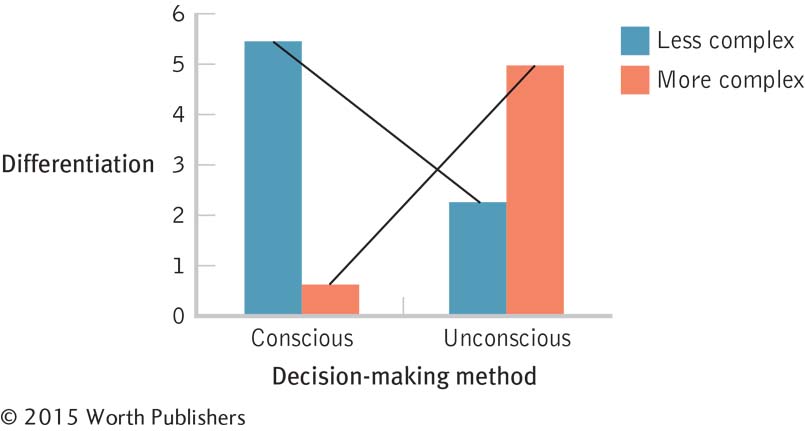
The Intersecting Lines of a Qualitative Interaction
When we draw two lines, one for the two bars that represent less complex situations and one for the two bars that represent more complex situations, we can easily see that they intersect. Lines that intersect, or would intersect if we extended them, indicate a possible interaction.
The qualitative interaction of decision-
So what do these findings mean for us as we approach the decisions we face every day? Which sunblock should we buy to best protect against UV rays? Should we go to graduate school or get a job following graduation? Should we consciously consider characteristics of sunblocks but “sleep on” graduate school–
339
CHECK YOUR LEARNING
| Reviewing the Concepts |
|
|
| Clarifying the Concepts | 12- |
What is the difference between a quantitative interaction and a qualitative interaction? |
| 12- |
Why are main effects ignored when there is an interaction? (We often say they are trumped by an interaction.) | |
| Calculating the Statistics | 12- |
Data are presented here for two hypothetical independent variables (IVs) and their combinations. IV 1, level A; IV 2, level A: 2, 1, 1, 3 IV 1, level B; IV 2, level A: 5, 4, 3, 4 IV 1, level A; IV 2, level B: 2, 3, 3, 3 IV 1, level B; IV 2, level B: 3, 2, 2, 3
|
| Applying the Concepts | 12- |
For each of the following situations involving a real-
|
Solutions to these Check Your Learning questions can be found in Appendix D.
340